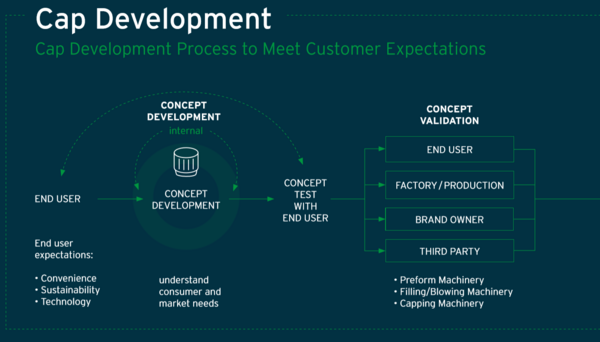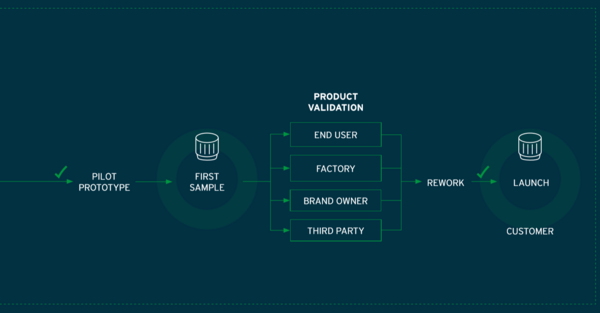

Aptar Food + Beverage
Aptar Food + Beverage Re-Invents Packaging for Tethered Caps to Enhance the Consumer Drinking Experience
Aptar Food + Beverage reimagines dispensing solutions to improve everyday life for people around the world. Both consumers and brands drive this need for innovation, and the need for more sustainable solutions is no different. To meet both of these needs, Aptar strives to continuously improve the consumer drinking experience, while also creating a solution that is better for the environment.
Aptar is proactive in developing sustainable solutions, knowing that consumers have become more environmentally aware. A recent study found that 56% of British consumers who drink bottled water feel guilty about the plastic waste /1/. Brands have also started focusing more on their sustainability efforts, and many have even made public pledges to meet certain goals. This trend toward more sustainable solutions guided Aptar’s development efforts when we began working on a tethered closure five years ago, prior to any legislation.

One challenge with tethered caps is that they affect the consumer experience differently, depending on where they are used. With a sport cap, consumers usually drink from the spout, so a tethered closure would not likely diminish their drinking experience. However, when it comes to flat caps, a tethered closure can actually create a negative consumer experience, as consumers are used to drinking or pouring from a bottle without any closure attached. This presented Aptar with the challenge of creating a closure that remains attached to the bottle, while at the same time, does not hinder the consumer’s drinking experience. Part of the solution stems from hinge functionality – allowing the closure to be far away from the consumer’s face when drinking – and the intuitiveness of the closure.
Aptar’s tethered flat cap development is guided by various technical requirements including:
- Having a wide hinge for ease of drinking
- Creating a “firm” hinge to ensure a robust closure that consumers can trust
- Engaging other senses, such as hearing. For example, our tethered flat cap has a “click” sound when the hinge is fully opened
- Designing an intuitive closure. You can have a great technical solution, but if the consumer does not understand how it works, their initial experience with the product will not be positive.
Incorporating a consumer-friendly solution for tethered flat caps does have some technical constraints. A big constraint is the minimum height to incorporate the tethered function, which could limit the possibility of having a shorter preform neck.
This limitation will be solved with Aptar’s new product category called “Flip Lid”. The main goal of this category is to create a tethered closure with an ultrashort neck, and improve the consumer experience. Generally, having a shorter neck with a flat cap has sustainability benefits, but also makes the cap harder to open. A flat cap can be easily unscrewed, because consumers are able to grip the cap, due to the height and diameter of the bottle neck. Having a shorter neck reduces the height, leading to a lower grip surface, and resulting in a flat cap that is more difficult to open.
However with Flip Lid the opening motion is a bit different. Consumers flip the lid up, widely open the hinge, and drink comfortably. A critical technical parameter for the opening is to have a well-designed, protruding element that will aid in gripping and lifting the lid. Compared to a tethered flat cap, Flip Lid provides an enhanced consumer drinking experience: a simple motion to open the lid, a wide opening for drinking comfort, and an audible click when the hinge is fully open and fully closed. Unlike a typical flat cap, with Flip Lid, there is no tradeoff between a shorter neck and ease of opening.
In addition to an improved consumer experience, switching from a standard screw-top cap to a lower neck finish with Flip Lid also greatly contributes to the sustainability efforts of brands. For example, a brand using 500 million flat caps per year in an 1881 neck finish that switches to a shorter 26/22 neck finish with Flip Lid will save more than 1,000 tons of raw material, which is equivalent to the carbon footprint of a car driving over 20 million km per year /2/. Raw material saving on the preform will also translate in cost savings. In the example above, preform PET raw material neck savings linked to the switch from 1881 to 26/22 will be more than 1 million € per year /3/.
Flip Lid also allows room for further PET preform weight optimization. For a screw-on application, a certain height is required for the thread to screw on to the closure. Flip Lid, being snapped-on during application, no longer requires this thread height. Flip Lid can open further opportunities to reduce preform weight, and optimize the use of plastic.
As the need for more convenient and sustainable packaging grows, Aptar continues innovating to meet the needs of both consumers, and brands.
_______________________
1 Mintel “A year of innovation in bottled water” June 2018
2 Assumption that in 1881 (closure weight is 2.2 Gr, and preform weight is 3.81 g) and in 26/22 (closure weight is 1.8 g, and preform weight is 1.85 g). Assumption of 140 g CO2 per km emission for a car, PET emission of 2,84 CO2 per Kg, and HDPE emission of 1,55 CO2 per Kg
3 From 1881 to 26/22, preform weight saving is 1.96 Gr. Assumption PET price = 1.2 €/kg, which equates to a saving => 1.96 x 1.2 x 500,000 = 1.17M €
The comPETence center provides your organisation with a dynamic, cost effective way to promote your products and services.

magazine
Find our premium articles, interviews, reports and more
in 3 issues in 2025.






